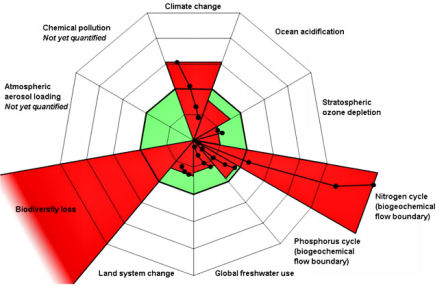The US Military is the largest single user of carbon based energy in the World. When you toss in the other worlds militaries, if we just cut the militaries of the world to patrolling borders global warming would backup by decades. Not only that but the Energy Companies are pushed around by the military big time. No military and the pirates take tankers…No Iraq war no Iraqui oil…No defense against China they suck all the world’s resources up like a vacuum cleaner…Do I feel sorry for the Energy Companies or the Military? No they deserve each other I just don’t think we deserve them. GO AWAY.
http://www.energybulletin.net/node/29925
I am not going to reprint the total article here…this guy did a lot of work on graphs and charts and things but it is interesting and he is not the only person to report on this. It is important to note that the Energy Bulletin has been adopted by the Post Carbon Institute (http://www.postcarbon.org/). Wonder when that happened?
Published May 20 2007 by Energy Bulletin
Archived May 21 2007
US military energy consumption- facts and figures
by Sohbet Karbuz
As the saying goes, facts are many but the truth is one. The truth is that the U.S. military is the single largest consumer of energy in the world. But as a wise man once said, don’t confuse facts with reality. The reality is that even U.S. Department of Defense (DoD) does not know precisely where and how much energy it consumes. This is my Fact Zero.
Below I give some facts and figures on U.S. military oil consumption based mostly on official statistics.[1] If you want to reproduce them make sure you read every footnote even if you need to put on your glasses. Also read the footnotes in this article.
FACT 1: The DoD’s total primary energy consumption in Fiscal Year 2006 was 1100 trillion Btu. It corresponds to only 1% of total energy consumption in USA. For those of you who think that this is not much then read the next sentence.
Nigeria, with a population of more than 140 million, consumes as much energy as the U.S. military.
The DoD per capita[2] energy consumption (524 trillion Btu) is 10 times more than per capita energy consumption in China, or 30 times more than that of Africa.
Total final energy consumption (called site delivered energy by DoD) of the DoD was 844 trillion Btu in FY2006FACT 2: Defense Energy Support Center (DESC) sold $13 billion of energy to DoD services in FY2006. More than half of it was to Air Force.
FACT 3: Oil accounts for more than three-fourths of DoD’s total site delivered energy consumption. Oil is followed by electricity (slightly more than 10%) and natural gas (nearly 10%). In terms of fuel types, jet fuel (JP-8)[3] accounts for more than 50% of total DoD energy consumption, and nearly 60% of its mobility[4] fuel.
FACT 4: Nearly three quarters of DoD site delivered energy is consumed by vehicles (or for mobility if you like). Only one quarter is consumed in buildings and facilities.[5]FACT 5: DoD consumed 97 million gasoline gallon equivalent in its non-tactical vehicles and for that it spent 238 million dollars.
FACT 6: In 2006, its oil consumption was down to 117 million barrels (or 320 thousand barrels per day),[10] despite increasing activity in Iraq and Afghanistan.
FACT 7: In 2006, for example, DESC reports in its Factbook that it sold 131 million barrels of oil (or 358 kbd) to DoD but DoD Federal Energy Management Report states that DoD consumed 117 million barrels (or 320 kbd).[12]
FACT 8: According to 2007 CIA World Fact Book there are only 35 countries in the world consuming more oil than DoD.
FACT 9: There exist no official estimates. Let me know if you see or hear one. According to my most pessimist estimates it is about 150 thousand barrels per day FACT 10: Whatever the true figure oil consumed by the U.S. military does not show up in world oil demand. See for more explanation under item #425 in October 2004 issue of ASPO Newsletter.
:}
For more of this incredibly insightful and well written article please go to the above website and see it..Even the Military is aware that it is seen as a BIG FAT energy PIG, but it is also aware that NO OIL = NO WAR
http://greeninc.blogs.nytimes.com/2009/05/19/addressing-the-militarys-energy-efficiency/
Addressing the Military’s Energy Inefficiency
By John Lorinc

The folks who gave the world the Hummer, the poster child of fuel inefficiency, want to spawn a new generation of eco-friendly military equipment with cross-over potential in the “civilian sector,” say a group of retired American military officers who released a sharply worded report on Monday calling on the Department of Defense to reduce its “carbon bootprint.”
“The American military gave you the Humvee, and now we’re taking it back,” said retired Adm. John Nathman, the former vice chief of naval operations and an adviser to President Obama, in a conference call on Monday. “You’re going to see some fairly dramatic movement by the Department of Defense in terms of public visibility.”
The report, “Powering America’s Defense,” was published by CNA Analysis and Solutions, a research group based in Alexandria, Va., that issued a previous study on defense and energy security in 2007.
In the new study’s preface, 12 retired military officers lay out the case for weaning the military — and the country — off oil:
Many of our overseas deployments were de?ned, in part, by the strategic decision to ensure the free ?ow of oil, to the U.S. and to our allies. Many of the troops we commanded were aided by air cover from high-thrust delivery systems that only an energy-intense society can provide. Many of these same troops were often burdened and imperiled by battle?eld systems that were energy-inef?cient. Some of the attacks on our troops and on American civilians have been supported by funds from the sale of oil. Our nation’s energy choices have saved lives; they have also cost lives.
As we consider America’s current energy posture, we do so from a singular perspective: We gauge our energy choices solely by their impact on America’s national security. Our dependence on foreign oil reduces our international leverage, places our troops in dangerous global regions, funds nations and individuals who wish us harm, and weakens our economy; our dependency and inef?cient use of oil also puts our troops at risk.
Senate Foreign Relations Committee ranking minority member chairman Richard Lugar, an Indiana Republican, told The Associated Press that he strongly agreed “with the stark conclusions” of the report, whose authors point out that fluctuating oil prices, dependence on foreign resources and an ailing electricity grid imperil national security both at home and abroad.
“Climate change is a threat multiplier,” said Vice Adm. Dennis V. McGinn, a retired officer and former commander of the Third Fleet.
Defense officials have previously described the American military as likely the world’s largest consumer of petroleum products, with an annual outlay in excess of $13 billion.
Each $1 per barrel increase in oil prices translates into $130 million of extra cost.
Calls for the military to address its environmental performance are not new. But in the past year or so, energy efficiency seems have become more of a priority, from a new solar wall installation at Fort Drum to the purchase of a large electric vehicle fleet for military bases.
:}
After all is said and done, are we safer with all this energy consumption? I think not:
http://www.commondreams.org/headline/2009/05/19-9
US Energy Use a National Security Threat: Study
WASHINGTON – US dependence on fossil fuels and a vulnerable electric grid pose a perilous threat to the country’s national security, retired military officers warned Monday in a report.
The threat requires urgent action and the Defense Department should lead the way in transforming America’s energy use by aggressively pursuing efficiency measures and renewable sources, said the report by CNA, a nonprofit research group.
“Our dependence on foreign oil reduces our international leverage, places our troops in dangerous global regions, funds nations and individuals who wish us harm, and weakens our economy,” it said.
“The market for fossil fuels will be shaped by finite supplies and increasing demand. Continuing our heavy reliance on these fuels is a security risk,” said the report titled “Powering America’s Defense: Energy and the Risks to National Security.”
The authors, top ranked retired officers from the US Army, Navy, Air Force and Marine Corps, also point to the strained domestic electricity network as a possible hazard for US military bases.
“Our domestic electrical system is also a current and significant risk to our national security: many of our large military installations rely on power from a fragile electrical grid that is vulnerable to malicious attacks or interruptions caused by natural disasters,” it said.
:}







